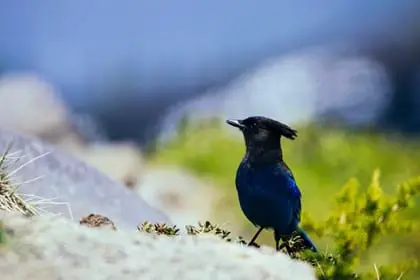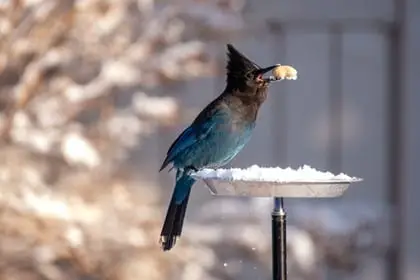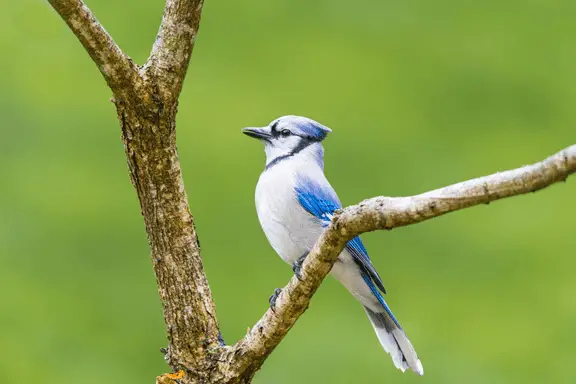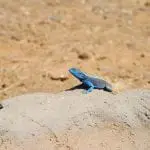
Blue objects are very attractive and one of the very attractive living blue things is blue jay. The blue jay also known as blue magpie has the scientific name Cyanocitta cristata and belongs to the Corvidae family. It is a very intelligent bird and adapts very easily to different situations. The bird can become very aggressive if it finds itself in a threatening situation. In addition to this, it is an omnivorous bird, that is, it can feed on different types of insects, carrion and even some types of vegetation. It is capable of making sounds similar to a hawk. It generally lives in forests and in India, it is the Odisha’s state bird.
Description of the Blue Jay
The blue jay measures about 30 cm from beak to tail and weighs 70–100 g. It has a wingspan of 34–43 cm. Its plumage is lavender blue to medium blue on the scalp, back, wings and tail, and its face is white. The underside is dirt white and the neck has a black collar that extends to the sides of the head. The wings’ hand pencils and tail feathers have strong stripes in black, sky blue and white. The beak, legs and eyes are completely black. Males and females are almost identical, but the males are slightly larger.
It has a distinct tassel on the head, a feather crown, which can be raised or lowered depending on the bird’s mood. When the bird is agitated or aggressive, the tassel can be set up correctly. When the bird is frightened, the tuft spreads outwards, like a brush. When the bird eats with species or rests, the tassel lies flat on its head.
As with other birds with blue tones, the color of the bluebird does not stem from pigment, but is due to light refraction due to the internal structure of the feathers. If a blue spring is crushed, the blue disappears because the structure is destroyed.
Habitat of the Blue Jay
The blue jay is a bird that can adapt to different types of habitat and is majorly seen in large forests that have different species of oak and beech. However, it can be even seen in city parks and home gardens.
Behavior of the blue jay

The blue jay is a bird with a very social character and they have the habit of establishing family ties with other blue jays. During winters, these beautiful blue objects usually migrate to the north where they move in flocks that can vary from 5 to 250 members. It is very common to see that not all blue jays migrate during winters. Also, some blue jays may migrate one year, but the following year they may decide to stay back. These are mysteries that have not yet been deciphered.
The blue jay has a very slow flight, so it is prone to being eaten by larger and faster birds such as owls or hawks when they are away from wooded areas.
The blue jay is a bird that tends to be very aggressive towards humans or any other species that approaches its nest. There have also been situations where if an owl sleeps in the surroundings of the blue jay’s nest, it will make a lot of noise during the day until the owl looks for another place. The way to know the changes of mood of this bird is based mainly on the crest that they carry on their head, which can extend upwards completely when it is very upset. It lowers it completely when it is scared, when it is feeding or when at rest with other jays.
The blue jay in addition to being very intelligent, social and aggressive when it feels threatened, is also very curious about shiny things.
The chirping
The chirping of these blue objects is very similar to that of other types of birds. But the most important is the vocalization that it performs to alarm its companions of some type of danger. This is a rather strident sound very similar to the sound that the seagull can make. The variety of sounds that this bird can make allows it to even copy the way humans speak.
Blue jay feeding

The blue jay when it goes to look for food, it does so by searching all over the ground and entering the trees. Since it is omnivorous, it feeds on different kinds of insects and vegetation. This includes different seeds, fruits, bread, acorns, the chicks of some birds, insects, meat, caterpillars, eggs and even garbage that can be found in parks or other urbanized areas.
Sometimes the blue jays are seen burying nuts and acorns in the ground in order to save it for another time. But over time they forget where they are and do not return. This helps to increase trees in forests and other areas. Sometimes it has been believed that the blue jay feeds mostly on chicks of other birds and their eggs. But this is not entirely true. It has been verified that only 1% of the population of blue jays had remains of chicks and eggs in their stomach or in excrement.
Reproduction
After forming the nest, the courtship and mating period of the blue jay begins. They are totally monogamous, that is, they spend their entire lives with the same partner. The blue jay reaches the peak of its sexuality when it reaches the first year of life and by this time it is fit enough to start a family. The mating season begins in the middle of March and the time when there is more reproductive action is between the months of April and May. Sometimes it could extend until July. After mating the female lays between 4 and 5 eggs where only the female will be the one that will incubate for around 16 to 21 days until the moment of hatching arrives.
Meanwhile the male will constantly go out to feed the female. Then it will also do so with the chicks which will be able to fly and defend themselves after being between 17 to 21 days old. When they have become young, they will leave the nest. It will be just at this moment when the entire family will be able to completely fly to another place when autumn arrives.
The age of the blue jay is around 7 years of age when they are in their natural habitat. But they have been seen to be 17 years old, on the other hand, in captivity.
Blue Jay nesting
The blue jay does not require a specific place or certain conditions to build its nest and reproduce. For this, these blue objects only need to be located in a tall tree or in a leafy bush that is between 3 meters and 10 meters high. It should allow them enough space to make the nest, which is made with a shape similar to a cup. Both male and female work together to build the nest and it is composed of different materials and vegetation. It may consist of thin branches of different sizes, roots of small trees, pieces of tree bark, moss, feathers and other birds. They may also use pieces of paper if they are near urbanized areas. What’s interesting is that they have been even seen layering mud to strengthen the nest structure.
The blue jay does not necessarily live in wooded areas. They like such area which is safer for them, for their nest and for their future young. They can nest without problems in areas that have been previously deforested. They have even been seen creating their nests in incredible places such as mailboxes of houses that are very characteristic of urban areas in the United States. They also tend to reuse nests that have previously been used by birds such as the robin.

Subspecies of the blue jay
Within the species that belongs to the blue jay, 4 subspecies are included. These were accepted for their peculiar characteristics, but they have very slight variations that differentiate them.
The Cyanocitta cristata bromia or also known as the Northern Blue Jay
This species of blue jay lives in Canada and in the United States towards the north. This is the subspecies that has the largest size, its plumage being exactly the same as the blue jay but with a slightly lighter blue color.
The Cyanocitta cristata
The Cyanocitta cristata are also known as the Coastal Blue Jay.
This species of blue jay lives in the United States, ranging from North Carolina to the city of Texas, with the exception of the southernmost part of Florida. This blue jay is medium in size and its blue color is much more intense than any of the other subspecies.
Cyanocitta cristata cyanotephra
Cyanocitta cristata cyanotephra are also known as the Inner Blue Jay.
This species of blue jay inhabits the United States, spreading throughout the interior of the country to the north. This blue jay is medium in size and its characteristic blue color is very dark, which contrasts perfectly with the ventral part of this bird, which is completely white.
The Cyanocitta cristata semplei
The Cyanocitta cristata semplei or also known as the Florida Blue Jay
This species of blue jay lives in the United States and is distributed throughout the south of the city of Florida. This species of blue jay is the one that is considered smaller, having its colors exactly the same as the blue jay or Florida Blue Jay.a


